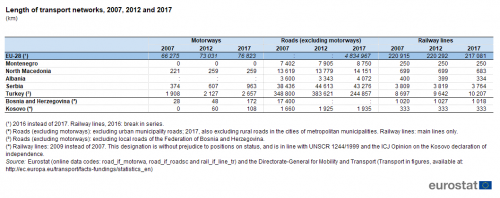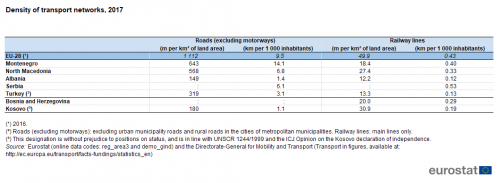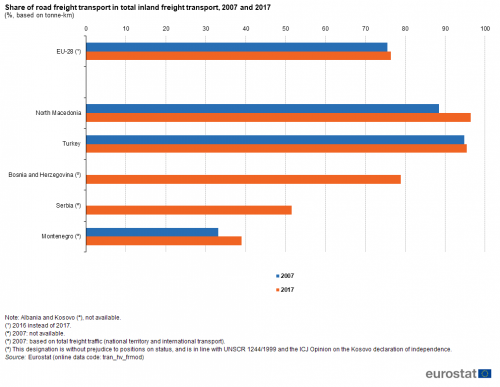Archive:Enlargement countries - transport statistics
Data extracted in February 2019.
Planned article update: April 2020.
Highlights
In 2017, the combined length of motorways in the EU enlargement countries was equivalent to 5 % of the total length of the EU motorway network.
In 2017, the combined length of railway lines in the EU enlargement countries was 16 600 km, equivalent to 8 % of the EU network.
In 2017, Montenegro had the highest motorisation rate among EU enlargement countries, with 310 passenger cars per 1 000 inhabitants.
Motorisation rate, 2017
This article is part of an online publication and provides information on a range of transport statistics for the European Union (EU) enlargement countries, in other words the candidate countries and potential candidates. Montenegro, North Macedonia, Albania, Serbia and Turkey currently have candidate status, while Bosnia and Herzegovina and Kosovo [1] are potential candidates.
The article provides information in relation to a range of transport statistics, including the length and density of transport networks, the motorisation rate and an analysis of freight transport.
Full article
Transport networks
In 2016, the EU-28 motorway network was approximately 77 000 kilometres (km) in length. Most of the enlargement countries are relatively small in terms of their total area and population numbers and so it is unsurprising to find that they generally had relatively small motorway networks, rarely more than a few hundred kilometres (see Table 1). The main exception was the largest enlargement country, Turkey, where the motorway network was 2 657 km long in 2017.The combined length of motorways in the enlargement countries was equivalent to 5.4 % of the total length of the EU-28 motorway network.

(km)
Source: Eurostat (road_if_motorwa), (road_if_roadsc) and (rail_if_line_tr) and the Directorate-General for Mobility and Transport (Transport in figures, available at: http://ec.europa.eu/transport/facts-fundings/statistics_en)
The motorway network in Turkey expanded between 2007 and 2017, as the length of Turkish motorways rose, on average, by 3.4 % per annum. Serbia (9.9 %) and Bosnia and Herzegovina (19.9 %) reported faster expansions in relative terms, while North Macedonia reported a slower increase (1.6 %); for comparison, the motorway network in the EU-28 grew on average by 1.7 % per annum between 2007 and 2016. The motorway network in Kosovo also expanded rapidly (no growth rate available), moving from no motorways in 2007 to a length of 108 km in 2017; in absolute terms, this increase was comparable to that recorded for Bosnia and Herzegovina, where the network grew from 28 km in 2007 to 172 km by 2017.
The EU-28 road network was estimated to be around 4.8 million km in length in 2016. As for motorways, Turkey had the longest road network (other than motorways) among the enlargement countries, at 245 000 km in 2017 (note that there is a large break in series in the Turkish data shown in Table 1 which excludes certain roads in urban municipalities), while there were 43 000 km of road in Serbia, which had the second most extensive road network.
There were 217 000 km of railway lines in the EU-28 in 2016, practically unchanged when compared with 2007 (note that there is a break in series). The combined length of railway lines in the enlargement countries was 16 600 thousand km in 2017, equivalent to 7.6 % of the EU-28 network.
The length of railway lines was unchanged in Montenegro and Kosovo between the years shown in Table 1, while there were slight contractions in Bosnia and Herzegovina, Serbia and North Macedonia and a larger contraction (in relative terms) in Albania. The length of the rail network in Turkey grew by an average of 1.6 % per year between 2007 and 2017, representing an extra 1 510 km of railway lines (note that the data for Turkey only cover main lines).
Relative to its population, Montenegro had the densest road network among the enlargement countries
Table 2 provides alternative measures of the relative importance of transport networks, presenting the density of networks in relation to the total land area and numbers of inhabitants. Montenegro and North Macedonia recorded the highest density of roads among the enlargement countries, with more than 500 m of road per square kilometre (km²) of land area in 2017. Using this measure, roads in Kosovo and Albania were spread more thinly across each territory, some 180 m and 149 m per km². For comparison, there was a much higher density of roads in the EU-28, estimated to be around 1.1 km per km² in 2016.

Source: Eurostat (reg_area3) and (demo_gind) and the Directorate-General for Mobility and Transport (Transport in figures, available at: http://ec.europa.eu/transport/facts-fundings/statistics_en)
An alternative network density measure is one which uses the number of inhabitants as its denominator. On this basis, the road network in Montenegro was at least twice as dense as in any other enlargement country, with an average of 14.1 km of road per 1 000 inhabitants in 2017; this was also higher than the average recorded in the EU-28 (9.5 km per 1 000 inhabitants in 2016). The road networks of Albania and Kosovo were again relatively sparse, using this measure, when compared with the remaining enlargement countries, with 1.4 km and 1.1 km of road per 1 000 inhabitants.
The rail network was particularly developed in Serbia
Across the EU-28, the density of railway lines was generally quite high in western and central Europe and lower in peripheral (especially sparsely populated) regions. In 2016, the rail network density of the EU-28 averaged 49.9 m per km² or 0.43 km of railway lines per 1 000 inhabitants.
Serbia had the highest rail network density among the enlargement countries in relation to its number of inhabitants, 0.53 km per 1 000 inhabitants in 2017, which was clearly above the EU-28 average. Indeed, Serbia was the only enlargement country to report a rail network density in relation to its number of inhabitants that was higher than in the EU-28. By contrast, Turkey and Albania reported the lowest ratios for their rail networks, regardless of whether this was in relation to land area or population size; note that the data for Turkey refer only to main lines.
Motorisation rate
The principal mode of passenger transport in the EU is the passenger car, providing both flexibility and mobility for personal journeys. In the EU-28, there were an estimated 507 passenger cars per 1 000 inhabitants in 2016. This marked an increase of 9.9 % in car ownership (or 46 additional cars per 1 000 inhabitants) when compared with 2007 (see Figure 1).

(passenger cars per 1 000 inhabitants)
Source: Eurostat (demo_gind) and the Directorate-General for Mobility and Transport (EU transport in figures, available at: http://ec.europa.eu/transport/facts-fundings/statistics_en)
Montenegro, Serbia and Bosnia and Herzegovina had the highest motorisation rates among enlargement countries
Motorisation rates for the enlargement countries in 2017 were considerably lower than in the EU-28. There were, on average, 310 passenger cars per 1 000 inhabitants in Montenegro, 280 per 1 000 inhabitants in Serbia and 252 per 1 000 inhabitants in Bosnia and Herzegovina; these were the highest rates among the enlargement countries. By contrast, motorisation rates in Kosovo, Turkey and Albania were below 160 passenger cars per 1 000 inhabitants.
During the 10-year period shown in Figure 1 there was faster growth in the motorisation rate in nearly all of the enlargement countries than in the EU-28, the only exception being Montenegro. The enlargement countries with the lowest motorisation rates in 2017 —Albania, Turkey, Kosovo and North Macedonia —recorded the fastest expansions in car ownership between 2007 and 2017. The highest rate of change was recorded in Kosovo, where the motorisation rate more than doubled. By contrast, in Montenegro the rate increased by 7 %, slightly less than the 10 % increase observed in the EU-28 (between 2007 and 2016).
Freight transport
The ability to move goods safely, quickly and cost-efficiently to markets is important for international trade, national distributive trades and economic development. The rapid increase in global trade up to the onset of the financial and economic crisis and the deepening integration of the EU, alongside a range of economic practices (including the concentration of production in fewer sites to reap economies of scale, delocalisation, and just-in-time deliveries), may explain the relatively fast growth of freight transport.
Within the EU-28, road freight accounted by far for the highest share of inland freight transport: in 2016, some 1 921 billion tonne-kilometres (tkm) of inland freight circulated using this mode of transport. Rail was the second most common mode for transporting inland freight (an estimated 412 billion tkm), while the relative importance of inland waterways was much lower. The EU-28 also transported (inward and outward transport combined) some 3.9 billion tonnes of sea freight in 2016 and 15.2 million tonnes of air freight and mail in 2017 (see Table 3).

Source: Eurostat (road_go_ta_tott), (rail_go_typeall), (mar_mg_aa_cwhd) and (avia_gooc)
Compared with road freight, the relative importance of rail freight within inland freight transport was higher in Montenegro and Serbia than in the other enlargement countries; note that Serbia had a relatively high share of inland freight transport on inland waterways (essentially on the Danube).
Sea freight was relatively important for Turkey, with 471 million tonnes loaded or unloaded in 2017, equivalent to 12.2 % of the EU-28 total in 2016. Elsewhere among the enlargement countries, sea freight was of low importance: note that North Macedonia, Serbia and Kosovo are all landlocked and therefore have no sea ports, while Bosnia and Herzegovina has only one coastal town and most of its freight destined for or coming from the sea passes through Croatian ports. Equally, Turkey was the only enlargement country with a relatively high level of air freight, with 1.3 million tonnes loaded or unloaded in 2017, equivalent to 8.5 % of the EU-28 total.
There was generally a high propensity to make use of roads for inland freight transport in both the EU and the majority of the enlargement countries (see Figure 2). While the share of road transport in total inland freight transport was 76.4 % across the EU-28 in 2016, there was an even greater reliance on using roads to transport freight in North Macedonia, Turkey and in Bosnia and Herzegovina, where 96.4 %, 95.4 % and 78.9 % of inland freight was moved by road in 2017. As noted above, there was a relatively high use made of rail for freight transport in Serbia and in Montenegro, as well as of inland waterways in Serbia. As a consequence the lowest shares for road freight transport among the enlargement countries for which data are available were in these two countries: 51.5 % in Serbia and 39.0 % in Montenegro.

(%, based on tonne-km)
Source: Eurostat (tran_hv_frmod)
Source data for tables and graphs
Data sources
Data for the enlargement countries are collected for a wide range of indicators each year through a questionnaire that is sent by Eurostat to partner countries which have either the status of being candidate countries or potential candidates. A network of contacts in each country has been established for updating these questionnaires, generally within the national statistical offices, but potentially including representatives of other data-producing organisations (for example, central banks or government ministries). The statistics shown in this article are made available free-of-charge on Eurostat’s website, together with a wide range of other socio-economic indicators collected as part of this initiative.
For the EU-28, the development of passenger and freight transport statistics is based upon a raft of framework legislation and implementing legislation, generally organised according to the mode of transport under consideration.
Transport statistics are available with an annual frequency and generally begin in the early 1990s. The majority are based on movements in each reporting country, regardless of the nationality of the vehicle or vessel involved (the ‘territoriality principle’). For this reason, the measure of tonne-kilometres (tkm or tonne-km, in other words, one tonne of goods travelling a distance of one kilometre) is generally considered a more reliable measure when analysing freight transport statistics, as the simple use of tonnes entails a higher risk of double-counting, particularly for international transport. The modal split of inland freight transport is based on transportation by road, rail and inland waterways, and therefore excludes air, maritime and pipeline transport. It measures the share of each transport mode in total inland freight transport and is based on tonne-kilometres.
The weight of goods transported by rail (and inland waterways) is the gross-gross weight. This includes the total weight of the goods, all packaging, and the tare weight of the container, swap-body and pallets containing goods; in the case of rail freight transport, it also includes road goods vehicles that are carried by rail. By contrast, the weight measured for maritime and road freight transport is the gross weight (in other words, excluding the tare weight).
Tables in this article use the following notation:
| Value in italics | data value is forecasted, provisional or estimated and is therefore likely to change; |
| : | not available; |
| – | not applicable. |
Context
An efficient and well-functioning passenger and freight transport system is vital for EU enterprises and inhabitants. The EU’s transport policy aims to foster clean, safe and efficient travel throughout Europe, underpinning the internal market for goods (transferring them between their place of production and consumption) and the right of citizens to travel freely throughout the EU (for both work and pleasure).
Transport infrastructure and transport networks are fundamental for the smooth operation of the economy, for the mobility of persons and goods and for the economic, social and territorial cohesion of a country. In September 2014, the European Commission invited EU Member States to propose projects to use EUR 11.9 billion of EU funding to improve European transport connections. This was the first tranche of the new funding for transport to be made available and also marked the largest ever single amount of EU funding earmarked for transport infrastructure. For the period 2014-2020, EUR 24 billion of financing has been foreseen for transport (around three times the EUR 8 billion during the period 2007-2013), under the Connecting Europe Facility (CEF).
EU transport policy also seeks to ensure that passengers benefit from the same basic standards of treatment wherever they travel within the EU. With this in mind the EU legislates to protect passenger rights across the different modes of transport. Passengers already have a range of rights covering areas as diverse as: information about their journey; reservations and ticket prices; damages to their baggage; delays and cancellations; or difficulties encountered with package holidays.
While basic principles and institutional frameworks for producing statistics are already in place, the enlargement countries are expected to increase progressively the volume and quality of their data and to transmit these data to Eurostat in the context of the EU enlargement process. EU standards in the field of statistics require the existence of a statistical infrastructure based on principles such as professional independence, impartiality, relevance, confidentiality of individual data and easy access to official statistics; they cover methodology, classifications and standards for production.
Eurostat has the responsibility to ensure that statistical production of the enlargement countries complies with the EU acquis in the field of statistics. To do so, Eurostat supports the national statistical offices and other producers of official statistics through a range of initiatives, such as pilot surveys, training courses, traineeships, study visits, workshops and seminars, and participation in meetings within the European Statistical System (ESS). The ultimate goal is the provision of harmonised, high-quality data that conforms to European and international standards.
Additional information on statistical cooperation with the enlargement countries is provided here.
Notes
- ↑ This designation is without prejudice to positions on status, and is in line with UNSCR 1244/1999 and the ICJ Opinion on the Kosovo declaration of independence
Direct access to
- Enlargement countries — statistical overview — online publication
- Statistical cooperation — online publication
- Statistical books/pocketbooks
- Key figures on enlargement countries — 2019 edition
- Key figures on enlargement countries — 2017 edition
- Key figures on the enlargement countries — 2014 edition
- Energy, transport and environment indicators — 2017 edition
- Leaflets
- Basic figures on enlargement countries — 2019 edition
- Basic figures on enlargement countries — 2018 edition
- Basic figures on enlargement countries — 2016 edition
- Energy and transport statistics for the enlargement countries — 2018 edition
- Transport (cpc_tr)
- Candidate countries and potential candidates: transport (cpc_transp)
- Transport, see:
- Multimodal data (tran)
- Transport, volume and modal split (tran_hv)
- Railway transport (rail)
- Railway transport measurement - goods (rail_go)
- Road transport (road)
- Road transport infrastructure (road_if)
- Road freight transport measurement (road_go)
- Inland waterways transport (iww)
- Inland waterways transport measurement - goods (iww_go)
- Maritime transport (mar)
- Maritime transport - main annual results (mar_m)
- Candidate countries and potential candidates (cpc) (ESMS metadata file — cpc_esms)